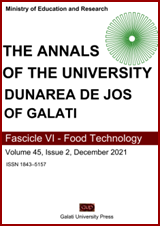Optimization of phenolic compound recovery and antioxidant activity from Fumaria officinalis L. using response surface methodology
Abstract
The purpose of this study was to optimize the extraction of antioxidant phenolic compounds from Fumaria officinalis by two approaches, single-factor experiment and response surface methodology (RSM). After extraction optimization, the content of polyphenols, flavonoids, and tannins was performed. Antioxidant activities of optimal extract were evaluated by DPPH, ABTS, and iron chelating activities. Single-factor experiments showed that all extraction parameters had significant effects (p < 0.05) on total phenolic content and free radical scavenging activity. From the optimization process using response surface methodology through Box-Behnken design regarding the three selected significant parameters (solvent concentration, extraction time, and temperature), it was established that the best extraction conditions were 47% methanol, 54.40°C, and 168.02 min, respectively. Under these optimal conditions, the recorded values for TPC and DPPH scavenging activity were successively 1510.10 mg GAE/100g DW and 69.85%. These results were in accordance with model predictions indicating that the model was suitable for the extraction process. Furthermore, higher flavonoids and tannins contents and strong iron-chelating and ABTS scavenging activities were obtained.


